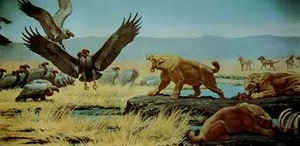
California Symbols
California State Fossil
Sabre-Toothed Cat

(Smilodon californicus)
Adopted on September 25, 1973
The sabre-tooth cat, Smilodon californicus, was adopted by the Legislature as the official State Fossil on September 25, 1973.
Sabertoothed cats are the most famous California Sabertoothed cats are the most famous California Ice Age fossil. Smilodon californicus was one of the last surviving
members of the formidable felines called sabertoothed cats. Ice Age fossil. Smilodon californicus was one of
the last surviving members of the formidable felines called sabertoothed cats.
The designation of the saber-toothed cat (Smilodon californicus) as the official state fossil of California was preceded by a Assembly Bill No. 698 introduced in the 1972 General Assembly by Assemblyman W.Craig Biddle proposing the trilobite, Fremontia fremonti, be adopted as the official state fossil of the State of California. In spite of the pressure of all of these endorsements, AB 698 never made it out of the Government Organization Committee to the Assembly floor for a vote
The next year, at the request of the Southern California Paleontological Society, another Assembly Bill No. 940 (AB 940), was introduced by Assemblyman Alan Sieroty. It did not support adoption of a trilobite as the state fossil, but proposed that the saber-toothed cat (Smilodon californicus) should be named to this honorary position. But before the bill could be bogged down in the Assembly's Government Organization Committee, Sieroty brought Dr. Giles Mead, director of the L.A. Counting Natural History Museum and Dr. Dan Savage, a UC Berkeley professor of paleontology to testify on behalf of the cat. Their expert testimony impress the members of the committee and they voted 8-0 in favor of passage of the bill. The Assembly followed suit and, on June 21, 1973, voted 72-0 without debate, to adopt Smilodon as the official state fossil of California.
California State Fossil: Sabre-Toothed Cat

The carnivorous sabertoothed cats (extinct members of the cat family Felidae) flourished throughout North America from the late Eocene and early Oligocene (40 to 35 million years ago) until the close of the Pleistocene about 11,000 years ago. In California, the cat's fossilized remains are most abundant at the La Brea Tar Pits (late Pleistocene) in Los Angeles. Here, the saber-toothed cat, attracted by the cries of struggling creatures caught in the sticky pools of asphalt, hunted them and in turn fell into the pools.
These animals lived on the North and South American continents during the Pleistocene period. In contrast to modern cats, saberthooths had
exceedingly long upper canines used to stab and slice. The upper canine teeth which are exceedingly long. The lower canines are somewhat reduced. The flange at the front
end of the lower jaw served as a guard for the upper canines. The jaw was so constructed that it could be opened nearly to a right angle. The canine teeth were very effective
in slicing wounds.

It is believed that these animals preyed mainly upon thick-skinned animals such as mastodons and elephants. Smilodon was approximately 350 kg and had a short tail, powerful legs and a large head. Its jaws could open 95 degrees and with 8-inch upper canine teeth it was a meat-eater. Smilodon was distinguished by its "saber teeth" or elongate canines. These were used to dispatch prey animals after a successful ambush, as Smilodon was not styled for fast running. Healed wounds on some sabertooths have been suggested as evidence that Smilodon hunted in packs and shared food with injured members until they could hunt again, although this interpretation is controversial. Fossil bones of the sabre-tooth cat have been found in abundance preserved in the tar pits of Rancho La Brea in Los Angeles.
The most famous and most concentrated deposit of Smilodon and other contemporary mammal remains is at the La Brea Tar Pits. This colonial-period ranch, with natural
asphalt seeps, is now a park surrounded by downtown Los Angeles. But for several thousand years during the Pleistocene, the tar pits - camouflaged by a covering of rainwater
-- served as traps for predator and prey alike. It is thought that packs of carnivores would follow a solitary, large animal (such as a mammoth) into the tar and become
mired, accounting for the large numbers of carnivore skeletons at the site.
Because of its abundance and scientific importance, the "saber-tooth cat," a reference to Smilodon, was designated the California state fossil in January of 1974 with the
passage of Government Code Section 420-429.5 adopted by the Legislature.
California Law
The law designating the sabre-toothed cat as the official California state fossil is found in the California Government Code, Title 1, Division 2, Chapter 2.
CALIFORNIA GOVERNMENT CODE
TITLE 1. GENERAL
DIVISION 2. STATE SEAL, FLAG, AND EMBLEMS
CHAPTER 2. STATE FLAG AND EMBLEMS
SECTION 420-429.8
425.7. The saber-toothed cat (Smilodon californicus) is the official State Fossil.
Taxonomic Hierarchy: Sabre-Toothed Cat
Kingdom: Animalia (animals)
Phylum: Chordata (having a spinal cord)
Subphylum: Vertebrata - vertebrates
Class: Mammalia (mammals)
Order: Carnivora
Family: Felidae
Genus: Smilodon
Species: Smilodon californicus

Some states that lack a "state fossil" have nevertheless singled out a fossil for formal designation such as a state dinosaur, rock, gem or stone.






